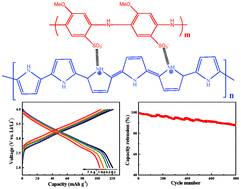Polypyrrole doped with redox-active poly(2-methoxyaniline-5-sulfonic acid) for lithium secondary batteries
Abstract
Polypyrrole is a promising electrode material for flexible/bendable energy storage devices due to its inherent fast redox switching, mechanical flexibility, easy processability and being environmentally benign. However, its low attainable capacity limits its practical applications. Here, we synthesise a polypyrrole/poly(2-methoxyaniline-5-sulfonic acid) (PPy/PMAS) composite by incorporating redox-active PMAS into a PPy matrix via an electropolymerization method. For comparison, polypyrrole containing the electrochemically inert dopant p-toluenesulfonate (PPy-pTS) was prepared under the same conditions. The resultant PPy/PMAS film shows greatly improved electrochemical properties by harnessing the contribution from PMAS, i.e. higher specific capacity, better rate capability and improved cycling stability when used as a cathode material in a lithium secondary battery. It delivers a high specific capacity of 120.6 mAh g−1 at a current density of 0.1 A g−1, and retains about 88.5% of the capacity (106.7 mAh g−1) over 800 consecutive cycles at a high current density of 1 A g−1.


 Please wait while we load your content...
Please wait while we load your content...